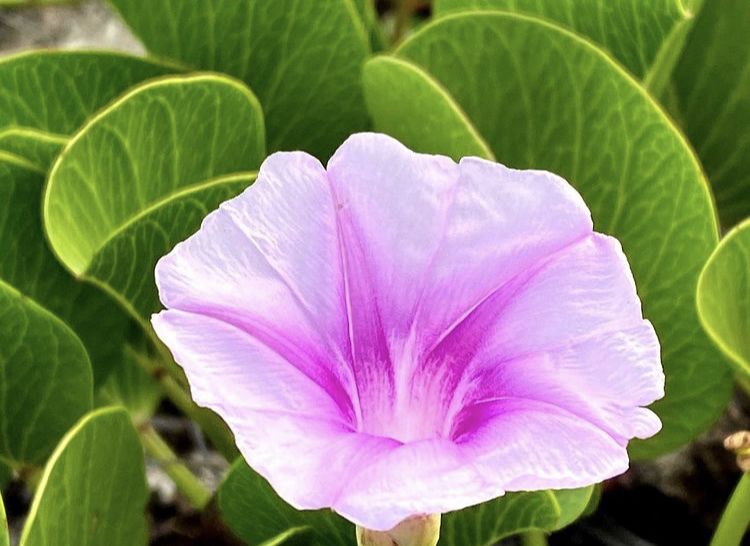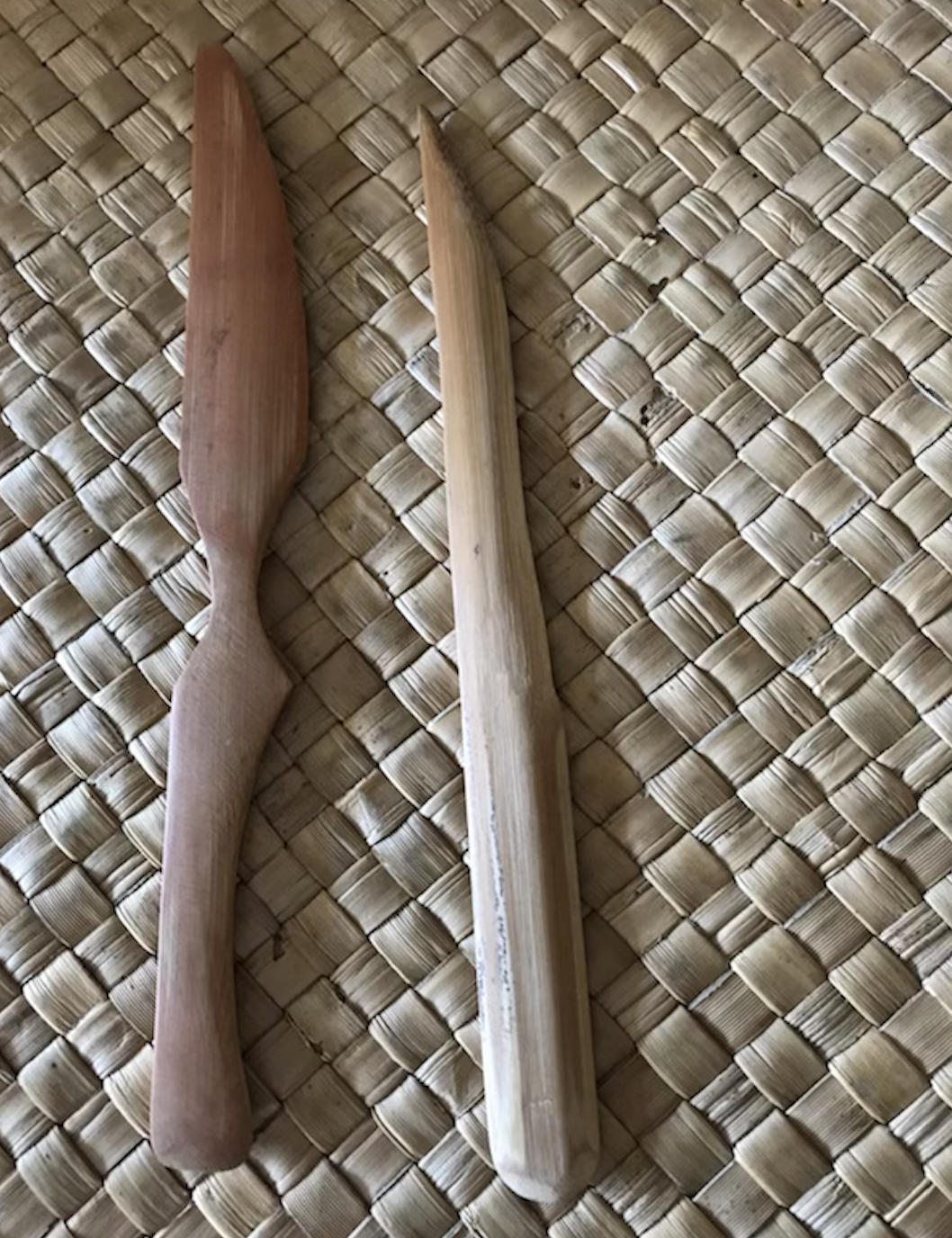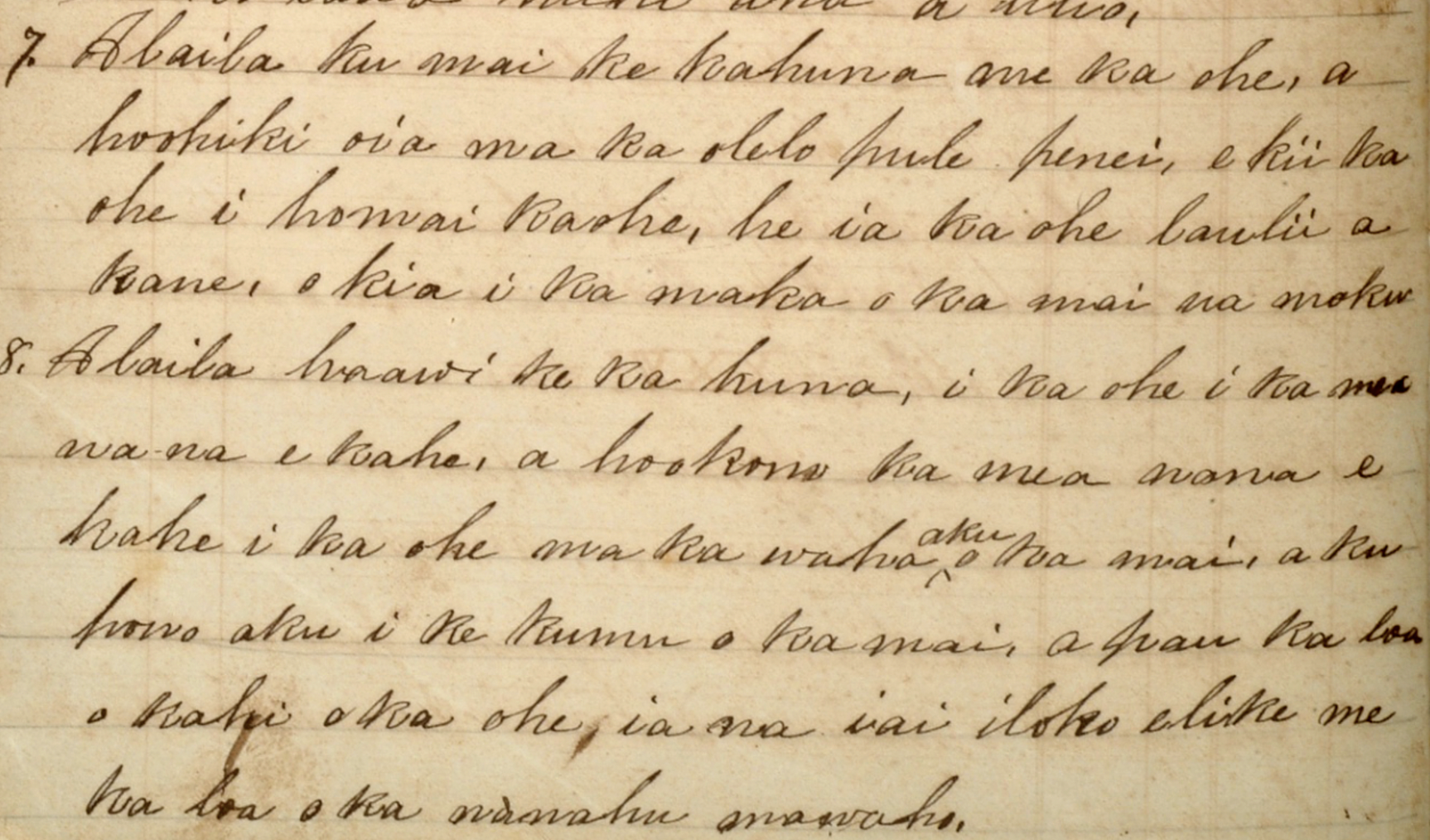Myrtle Diaz
Ka Mālama Maʻi Keiki

Mānaleo Series
These short clips of native speakers on Ka Leo Hawaiʻi talking about their lives and practices are invaluable windows into our past, our language, and ourselves. Our mahalo kūhohonu goes out to Larry Kimura and Puakea Nogelmeier for their foresight in preserving the voices of these hulu kupuna.
Listen and read along:
1. Press "listen in browser" or the orange arrow on the sound file below (make sure your sound is up).
2. Scroll down and read along in the language of your choice.
3. Repeat as needed.
4. Remember to select "listen in browser" to stay in this site.
Myrtle Diaz discusses the practices done to care for the genitals of babies.
Larry Kimura (LK): Pehea hoʻi ka pēpē kāne, he kahe ʻia nō ka ule ma leila nō a mau pule aku paha?
Myrtle Diaz (MD): Mau lā, mau lā.
LK: Pehea ke ʻano o ke kahe ʻana o ka wā ma mua? No ka mea, ʻaʻohe nō maopopo ke ʻano o ka wā ma mua.
MD: ʻOki lākou i ka, ʻoki lākou i ka ʻohe. Kohu pahi.
LK: ʻĒ. ʻOi.
MD: Hoʻokomo hoʻokahi uh, ʻohe malalo o ka ʻili.
LK: ʻĒ
MD: Kēlā ʻili o ke poʻo. Ka mea ʻoi, ʻoki lākou. Kēlā wale nō. ʻAʻole lākou ʻoki poepoe, [e] like me ka haole. ʻAʻole. Ko lākou ʻoki ʻana, he kahe wale nō.
LK: Kahe wale nō.
LK: A waiho?
MD: A waiho. Kau, kau [i] ka lāʻau. I puhole mai hoʻi ka poʻo.
LK: ʻĒ, ʻē. ʻOia kā! A maʻemaʻe nō hoʻi?
MD: Ahh.
LK: Ē. ʻO ia nō ke kahe ʻana?
MD: ʻAe.
LK: Ua moʻolelo nō kekahi o koʻu ʻohana iaʻu, e pili ana i ke kahe ana. Ua ʻike nō ʻo ia, a puhi nō ka makuahine i kēia...
MD: Puhi. ʻAe. Kekahi poʻe hana me kēlā. ʻAʻohe lākou makemake e kahe, no leila puhipuhi lākou.
LK: Puhipuhi, me ka waha nō?
MD: Yeah, me ka waha. Paʻa lākou i ka, ka ule, puhi lākou ma ka...
LK & MD: Laughter
LK: A pohole mai.
MD: A pohole mai.
LK: ʻĒ, ʻē, ʻē. ʻOia kā.
MD: Like nō hoʻi me nā poʻe kaikamāhine.
LK: He ʻokoʻa nō ko lākou.
MD: ʻOkoʻa nō ko lākou. He lomilomi.
LK: ʻĀ!
MD: Huki aʻela [i] ka ʻaoʻao o ka maʻi i nui ka pale o luna.
LK: ʻĀ! Makemake ʻia kēlā?
MD: Mhmm
LK: A hana ʻia pēlā?
MD: ʻAe

Unuhina (Translation):
Larry Kimura (LK): What about baby boys, was the foreskin of the penis cut at that time [birth] or maybe a few weeks later?
Myrtle Diaz (MD): A few days later. A few days.
LK: How was this cutting done in the past? Because I don’t know how it was done in the past.
MD: They would cut the bamboo. Like a knife.
LK: Yes. It’s sharp.
MD: They would insert a bamboo knife under the skin. The skin on the head [of the penis]. The bit that sticks out, they would cut it. That’s it. They didn’t do circumcision, like the foreigners do. No. Their method of cutting was just subincision of the foreskin.
LK: Subincision only. And then leave it?
MD: Leave it. Apply some medicine. So the skin peels back and exposes the head.
LK: Is that right? And so it’s clean?
MD: Yes.
LK: Yeah. So that’s subincision of the foreskin.
MD: Yes.
LK: One of my family members told me a story about the subincision process. He knew about it and said they would blow [into the uncut foreskin]...
MD: Yes, they would blow. Some people did it like that. They didn’t want to cut the foreskin, so they would blow into it instead.
LK: Blow…with their mouth?
MD: Yeah, with the mouth. They would hold the penis and blow [into the foreskin to loosen it].
LK & MD: Laughter
LK: And the foreskin would eventually peel back?
MD: It would peel back.
LK: Yes, yes. That’s it.
MD: Like with the baby girls.
LK: What they did with them was different?
MD: Yes, it was different for them. They would massage it. They would pull on the labia so that it formed a good size covering.
LK: Ahhh, ahhh. That’s what was desired?
MD: Mhmm
LK: So it was done that way?
MD: Yes.

Koali flowers had a similar shape to these pōhuehue blossoms and were often placed on the head of the penis after the operation to keep it clean and protected.


Koali flowers had a similar shape to these pōhuehue blossoms and were often placed on the head of the penis after the operation to keep it clean and protected.
Koali flowers had a similar shape to these pōhuehue blossoms and were often placed on the head of the penis after the operation to keep it clean and protected.
He ʻĪnaʻi
It's quite fascinating to hear Mrs. Diaz says that some folks didn't want to do any cutting so they would loosen the foreskin with regular blowing so that it would eventually peel back. It shows how there was individual choice and that one approach did not work for everyone.
When subincision of the foreskin was chosen, for some (not all) it was a ritualized process that was part of the larger kā i mua ceremonies for young boys when they left the daily care of the women and were initiated into the men's house. With the tying on of the malo came the kuleana of being a kāne. Hawaiian scholar and cultural authority David Malo describes the process in detail and it is full of great words to add to your waihona huaʻōlelo (vocabulary):
David Malo: No ke ʻoki kahe ʻana i nā keiki ma ka maʻi
A ma hope iho o ke kā ʻana i mua, a māhuahua iki aʻe ke keiki, ʻo ia ka wā pono ke kahe ka ʻolomua o ke keiki. ʻO ke kahe ʻana, he ʻoihana hoʻomana nō ia, ua like pū nō ka hoʻomana ʻana me ko ke kā ʻana i mua.
Penei ka ʻoihana kahe maʻi: e mōhai ʻia nō ka puaʻa i ke akua no ke kahe ʻana i mea e ʻoluʻolu mai ai ke akua; e ʻākoakoa mai nō nā makamaka
o ka makua o ua keiki lā ma ke anaina hoʻomana no ke kahe ʻana. A ma ka wā e kālua ai ua puaʻa lā i mōhai ʻia ai, ʻo ia ka wā e kahe ai i ka maʻi o ua keiki lā. Penei e hana ai.
ʻEhā kānaka nāna e paʻa ke keiki, a ʻo kahi kanaka ma ke kua o ke keiki, a pili aku kona alo ma ko keiki kua, a hoʻokomo i kona lima ma lalo o ka poʻohiwi o ke keiki, a ʻōpeʻa aʻe i kona lima ma ka ʻāʻī o ke keiki, a pūliki
mai a paʻa ke keiki i hiki ʻole ke ʻoni aʻe.
A ana ʻia ka loa o ka ʻolomua mai ka wēlau aku o ka ʻōmaka a pili aku nō i ko loko, a kakaha ʻia ma luna iho i ka nānahu ahi a ʻeleʻele, a ana ʻia ka loa ma ka ʻohe ma kahi o ka ʻohe e komo ai i loko o ka maʻi e like me ke ana ʻana i ka nānahu ahi ma luna iho o ke kua o [ka] maʻi.

Modern pahi ʻohe (bamboo knife). Pic: Lisa Schattenburg Raymond.
A laila, paʻa ka lima hema o kekahi kanaka ma ka ʻūhā o ke keiki, a ʻo ka lima o ua kanaka lā, paʻa maila ma kekahi ʻaoʻao ma ka ʻalu o ka waha o ka maʻi o ua keiki lā a pēlā nō ka hana a kekahi kanaka ma kēlā ʻaoʻao o ua keiki lā, a i ko lāua lena ʻana a mālō ka ʻalu o ka maʻi no ko lāua huki ʻana a lilio.
A laila, kū mai ke kahuna me ka ʻohe a hoʻohiki ʻo ia ma ka ʻōlelo pule penei, "E kiʻi [i] ka ʻohe i Hōmaikaʻohe! Hē ʻia ka ʻohe lauliʻi a Kāne. ʻOkia i ka maka o ka maʻi! Ua moku." A laila, hāʻawi ke kahuna i ka ʻohe i ka mea nāna e kahe, a hoʻokomo ka mea nāna e kahe i ka ʻohe ma ka waha aku o ka maʻi a kūpono aku i ke kumu o ka maʻi. A pau ka loa o kahi o ka ʻohe i ana ʻia ai i loko e like me ka loa o ka nānahu ma waho.

David Malo's original writings, photographs of which were published in Kapali Lyons' recent book on Malo.
A laila, hele aʻela a moku ma ka loa o ka maʻi; a laila, omo ʻia ke koko a hoʻokomo ʻia i ka pua lāʻau ma ka ʻōmaka o ka maʻi a hoʻohume ʻia ua keiki lā i ka malo keʻokeʻo. A ma ka wā e moʻa ai ka puaʻa, a laila, hoʻomana hou nō e like nō me kēlā ʻoihana hoʻomana ma mua i ka wā i kā ʻia ai ua keiki lā i mua.
Pēlā nō ka hoʻomana ʻana a me ka pule ʻana. Pēlā nō e hana ʻia ai nā keiki a ka poʻe haipule, a me ka poʻe koʻikoʻi, a me ka poʻe hanohano, a me ka poʻe kāhuna, a me ka poʻe aliʻi haʻahaʻa. He ʻokoʻa ka hana ʻana i nā keiki a ka poʻe aliʻi kiʻekiʻe. A ʻo nā keiki a kekahi poʻe, ʻaʻole nō i hana ʻia pēlā; e lawe wale aku nō kā lākou mau keiki i mua a e kahe wale iho nō me ka hoʻomana ʻole i ke akua.
ʻAʻole naʻe e hānai ʻia kā nā kāhuna keiki a me kā nā aliʻi mau keiki i ka ʻai noa i ko lākou wā e ʻai waiū ana ma ka hale noa. I mua nō lākou e hānai ʻia ai i ka ʻai maoli. ʻO ka waiū wale nō kā lākou e ʻai ai ma ka hale noa. Pēlā e hana ai kekahi poʻe i kā lākou keiki.
Na Hina Kneubuhl i kākau a hoʻonohonoho i kēia moʻolelo. Mahalo nui iā Helena Bakutis i ke kōkua ʻana mai ma ka palapala leo a me ka unuhi ʻōlelo.
These pieces are all working interpretations. Should you see a kuhihewa, kiko hewa, or have any sort of manaʻo to share, please email kauamelemele@gmail.com - Mahalo!
Click here to access the full recording on Kaniʻāina.

Modern pahi ʻohe (bamboo knife). Pic: Lisa Schattenburg Raymond.
Modern pahi ʻohe (bamboo knife). Pic: Lisa Schattenburg Raymond.

David Malo's original writings, photographs of which were published in Kapali Lyons' recent book on Malo.
David Malo's original writings, photographs of which were published in Kapali Lyons' recent book on Malo.
